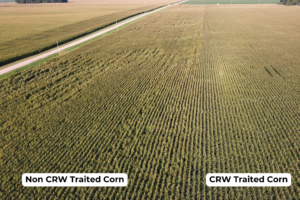Corn Rootworm Management
In this agronomic report, we aim to address the challenges posed by corn rootworm infestations throughout the current season. A pivotal aspect of managing the corn rootworm population involves targeting the larvae shortly after their emergence from eggs, while they are still no larger than 1/8″. During this critical period, a well-timed rainfall event can effectively eliminate up to 98% of the rootworm population. Typically, there exists a narrow window of opportunity, lasting approximately 10 to 14 days in June, when the rootworm larvae are vulnerable to population reduction through rainfall.
The field depicted in this video is a farm located south of Alpha, MN. From the time of planting until August 30th, it has received a total of 12 inches of rainfall in 2023. Comparatively, during the same timeframe in 2022, this field received 12.48 inches of rainfall, and in 2021, the figure was 10.5 inches. The crucial factor lies in the amount of rainfall received from early June to early July. In 2023, it received only 1.1 inches during this period, primarily in small increments. In 2022, it received 3.8 inches, while in 2021, it was a mere 0.67 inches. The light rainfall totals in 2023 and 2021 contributed to increased pressure from corn rootworms (CRW).

Long-lasting Impact
A portion of the challenges we face can be traced back to the 2021 season when we observed substantial populations of rootworm beetles. Northern Corn Rootworm beetles are known to exhibit extended diapause, depositing their eggs in current cornfields that do not hatch during the subsequent growing season but rather wait for the one thereafter. Additionally, Western corn rootworm beetles have been prevalent in our cornfields this year, characterized by their tendency to lay eggs in neighboring soybean fields.
Drought conditions also hinder the corn plant’s capacity to regenerate its root mass. If regeneration does not occur promptly after feeding, the root becomes hardened, impacting the plant’s ability to absorb nutrients through diffusion. Reduced root mass translates to a smaller area of soil explored for essential nutrients such as phosphorus and potassium. Notably, a corn plant yielding 200 bushels per acre stores nearly 220 pounds of potassium in its corn stover alone. Even though a lesser amount is removed in the corn grain, potassium remains critical for stalk stability and overall plant integrity.
Take Action Now
We strongly encourage you to engage in discussions with your Agronomy Account Manager and assess the condition of your cornfields as you strategize for the 2024 season. It’s essential to keep in mind the extended diapause factor affecting the 2025 season. Now is the ideal time to begin conversations about seed choices, determining whether the battle against rootworms should involve genetic traits, in-furrow insecticides, or a combination of both in specific cases. Proactive planning will ensure the availability of the most suitable option for your farming operation if concerns arise.


